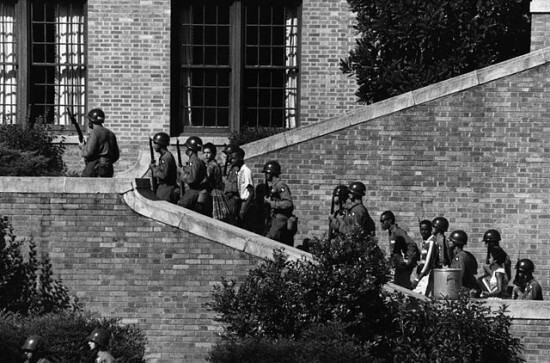
The group of young high school students known as the Little Rock Nine were the nine African-American students involved in the desegregation of Little Rock Central High School. In 1975 their entrance into the school sparked a nationwide crisis when Arkansas governor Orval Faubus, in defiance of a federal court order, called out the Arkansas National Guard to prevent the Nine from entering. President Dwight D. Eisenhower responded to the crisis by federalizing the National Guard on September 25, 1957 and sent in units of the U.S. Army’s 101st Airborne Division to escort the Nine into the school. The military presence would remain for the duration of the school year.
Before being moved to attend Little Rock Central High, the Nine attended segregated schools for black students in Little Rock (Pulaski County). Carlotta Walls, Jefferson Thomas, and Gloria Ray attended nearby Paul Laurence Dunbar Junior High School, while Ernest Green, Elizabeth Eckford, Thelma Mothershed, Terrence Roberts, Minnijean Brown, and Melba Pattillo attended Horace Mann High School.
On May 24, 1955, the Little Rock School Board voted to adopt a plan for gradual integration. This plan was known as the Blossom Plan or the Little Rock Phase Program. The plan was designed for desegregation to begin in the fall of 1957 at Central and filter down to the lower grades over the next six years. The plan was set up to permit students to transfer from any school where their race was in the minority, thus ensuring that the black schools would remain racially segregated.
The Nine attempted to enter Central High on September 4, 1957 but were turned away by Arkansas National Guard troops called out by the governor. In addition the crowds that gathered were angry and abusive to the young teenagers and forced them to turn away. When Elizabeth Eckford arrived at the campus at the intersection of 14th and Park Streets, she was confronted by an angry mob of segregationist protestors. She attempted to enter at the front of the school but was directed back out to the street by the guardsmen. The rest of the Nine arrived the same day and gathered at the south, or 16th Street, corner where they and an integrated group of local ministers who were there to support them were also turned away by guardsmen.
The Nine were forced to remain at home for more than two weeks, trying to keep up with their schoolwork as best they could. The federal court eventually ordered the governor to stop interfering with the court’s order and Faubus removed the guardsmen from in front of the school. It was on September 23rd, the Nine entered the school for the first time. The crowd outside was incensed and chanted, “Two, four, six, eight! We ain’t gonna integrate!” and then chased and beat black reporters who were covering the events. The Little Rock police became fearful that they could not control the increasingly unruly mob in front of the school and removed the Nine later that morning. They were forced once again to return home and wait for further information on when they would be able to attend school. On September 25, 1957 the Nine were finally under federal troop escort, brought back into Central for their first full day of classes.
The Nine continued to suffer repeated harassment including kicking, shoving and name calling. It intensified so much that the military assigned guards to escort them to classes. Unfortunately the guards could not go everywhere with the students, and harassment continued in places such as the restrooms and locker rooms. The Little Rock Nine were not allowed to have any classes together. They were also not allowed to participate in extracurricular activities at Central. Nevertheless, despite all the obstacles they returned to school every day to persist in obtaining an equal education.
Minnijean Brown was the only student to fight back against the harassment and eventually left the school to move to New York City where she graduated from Lincoln High School. The other eight students chose to remain at Central until the end of the school year. On May 27, 1958, Ernest Green became Central’s first black graduate. Despite the valiant efforts of the Nine they like their counterparts across the district, were forced to attend other schools or take correspondence classes the next year when voters opted to close all four of Little Rock’s high schools to prevent further desegregation efforts. Yet without the bravery and stamina of these young students the first step at desegregation would have never happened. The impact of the Little Rock Nine continues to be felt and honored even today.

Leave a Reply